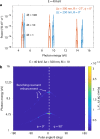Monochromatic X-ray Source Based on Scattering from a Magnetic Nanoundulator
- PMID: 32596415
- PMCID: PMC7311110
- DOI: 10.1021/acsphotonics.0c00121
Monochromatic X-ray Source Based on Scattering from a Magnetic Nanoundulator
Abstract
We present a novel design for an ultracompact, passive light source capable of generating ultraviolet and X-ray radiation, based on the interaction of free electrons with the magnetic near-field of a ferromagnet. Our design is motivated by recent advances in the fabrication of nanostructures, which allow the confinement of large magnetic fields at the surface of ferromagnetic nanogratings. Using ab initio simulations and a complementary analytical theory, we show that highly directional, tunable, monochromatic radiation at high frequencies could be produced from relatively low-energy electrons within a tabletop design. The output frequency is tunable in the extreme ultraviolet to hard X-ray range via electron kinetic energies from 1 keV to 5 MeV and nanograting periods from 1 μm to 5 nm. The proposed radiation source can achieve the tunability and monochromaticity of current free-electron-driven sources (free-electron lasers, synchrotrons, and laser-driven undulators), yet with a significantly reduced scale, cost, and complexity. Our design could help realize the next generation of tabletop or on-chip X-ray sources.
Copyright © 2020 American Chemical Society.
Conflict of interest statement
The authors declare no competing financial interest.
Figures




References
-
- Sakdinawat A.; Attwood D. Nanoscale x-ray imaging. Nat. Photonics 2010, 4, 840.10.1038/nphoton.2010.267. - DOI
-
- Hitchcock A. P. Soft X-ray spectromicroscopy and ptychography. J. Electron Spectrosc. Relat. Phenom. 2015, 200, 49–63. 10.1016/j.elspec.2015.05.013. - DOI
-
- Schmitz C.; Wilson D.; Rudolf D.; Wiemann C.; Plucinski L.; Riess S.; Schuck M.; Hardtdegen H.; Schneider C. M.; Tautz F. S.; Juschkin L. Compact extreme ultraviolet source for laboratory-based photoemission spectromicroscopy. Appl. Phys. Lett. 2016, 108, 234101.10.1063/1.4953071. - DOI
-
- Solak H. H. Nanolithography with coherent extreme ultraviolet light. J. Phys. D: Appl. Phys. 2006, 39, R171–R188. 10.1088/0022-3727/39/10/R01. - DOI
-
- McNeil B. W. J.; Thompson N. R. X-ray free-electron lasers. Nat. Photonics 2010, 4, 814.10.1038/nphoton.2010.239. - DOI
LinkOut - more resources
Full Text Sources
